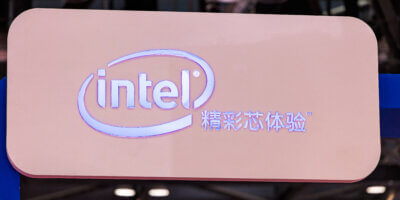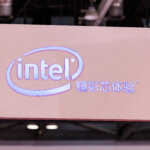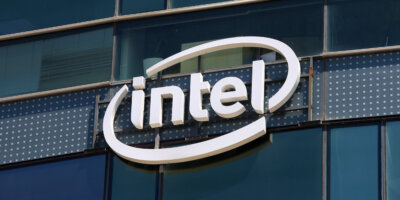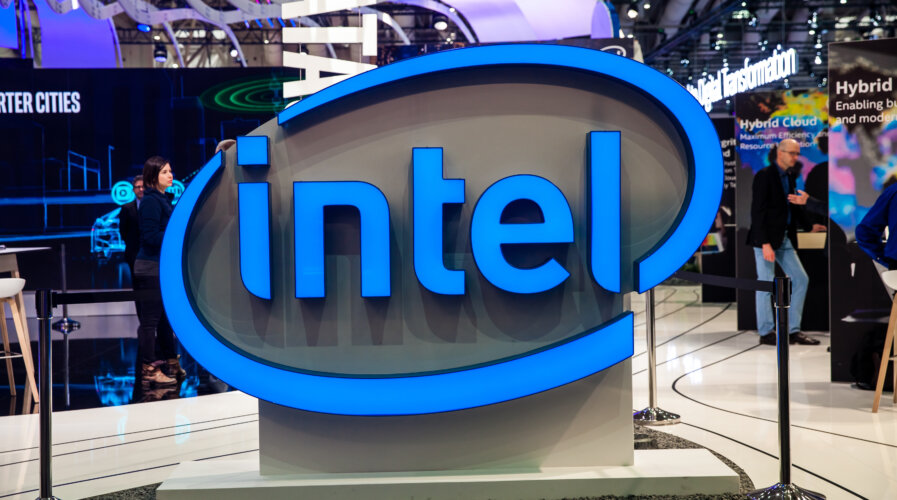
Intel is building a factory in Penang, Malaysia, and it will soon be the US chip giant’s first overseas facility for advanced 3D chip packaging.Source: Shutterstock
Intel is building its largest 3D chip packaging facility in Malaysia
- Intel is building a factory in Penang, Malaysia, and it will soon be the US chip giant’s first overseas facility for advanced 3D chip packaging.
- Intel also built a chip assembly and testing factory in another district in Malaysia as part of a US$7 billion expansion.
- The question is whether Intel can weather a cyclical collapse in demand to make good on its expansion plans.
In the global semiconductor value chain, Malaysia has always been a global center for testing and assembling – and no-one knows that better than Intel Corp. The US chip giant has been in the Southeast Asian nation for the last 51 years, with Malaysia opening Intel’s first international manufacturing facility in 1972.
In December 2021, the company renewed its commitment, that includes a US$7 billion investment over the course of a decade, bringing the total investment in Malaysia by the US chip giant to US$14 billion as of 2032. The US$7 billion in investments is mainly to increase the size of its operations in Penang and Kulim, Kedah.
As it is, Malaysia is Intel’s largest offshore site, with a workforce exceeding 10,000 employees across two campuses in Penang and Kulim. It is one of the largest assembly and test facilities, and a mature site with multi-functions in manufacturing, design, development, and local and global support services.
It has just been revealed that another factory being built in Penang will be Intel’s first overseas facility for advanced 3D chip packaging, known as Intel’s Foveros technology. Malaysia will eventually become Intel’s largest production base for 3D chip packaging, Robin Martin, corporate vice president for manufacturing supply chain and operations, told reporters this week.
The company, however, did not specify when the facility would begin mass production. A report by Nikkei Asia quoted Intel saying that Amazon, Cisco, and the US government have committed to using its advanced packaging technology.
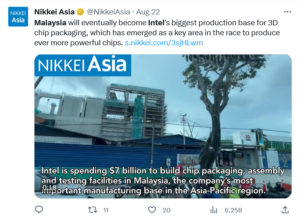
Onward and upward for Intel in Malaysia?
The company is also building a chip assembly and testing factory in Kulim for its US$7 billion expansion in Malaysia. For context, Malaysia is currently the world’s sixth-largest exporter of semiconductors, and Intel contributes an average of 20% of its total semiconductor exports annually.
Malaysia alone accounts for 13% of the world’s chip testing and packaging, a critical step in reading semiconductors for cars, phones, and other devices.
Penang has emerged as the nation’s electrical and electronics hub. Over half a million people were employed in the E&E industry as of 2022, working with global chipmakers from STMicroelectronics NV and Infineon Technologies AG to Intel and Renesas Electronics Corp.
Intel in Asia
Since Pat Gelsinger took the helm, Intel has viewed Asia more prominently, while being aware that the US needs to catch up to be on par with its Asian rivals. Even in Vietnam, Intel took a giant step into the country as the first and largest major foreign high-tech investor about a decade ago.
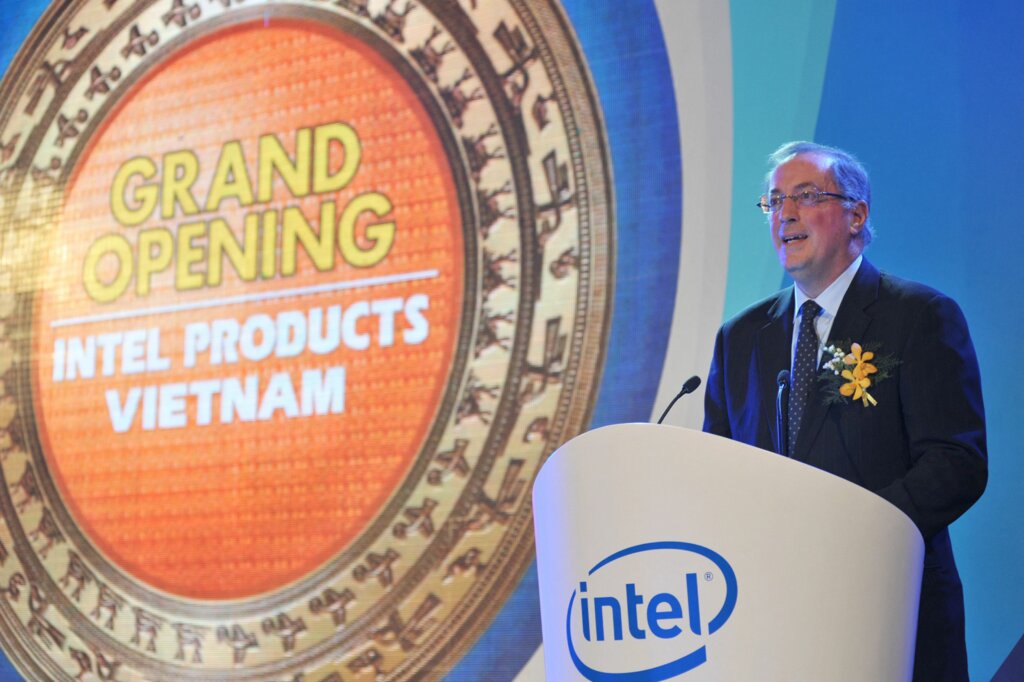
Paul Otellini, the former chief executive of Intel, delivers a speech at the opening ceremony of Intel’s assembly and test facility in Ho Chi Minh City on October 29, 2010. US-based chip maker Intel opened a billion-dollar plant in Southern Vietnam, the company’s biggest in the world, expected to create thousands of skilled jobs as the nation moves from low to hi-tech. AFP PHOTO (Photo by AFP / AFP)
By the end of 2021, Intel had injected a total of US$1.5 billion in Vietnam, and there had been talks that the US chip giant was planning a significant increase in that existing investment. The aim is to expand its chip testing and packaging plant in the Southeast Asian nation, two sources familiar with the matter told Reuters.
The possible move, which one source said could be worth around US$1 billion, would signal a growing role for Vietnam in the global supply chain for semiconductors as companies push to cut reliance on China and Taiwan because of political risks and trade tension with the US. Gelsinger also believes that it is not “palatable” that so many computer chips are made in Asia.
Most processors are currently manufactured in the region, with Taiwan’s TSMC and South Korea’s Samsung as the dominant players. Intel needs TSMC’s advanced manufacturing services and plans to compete with the Taiwanese giant in the so-called foundry business, a tricky balancing act for the CEO.
Intel in the West
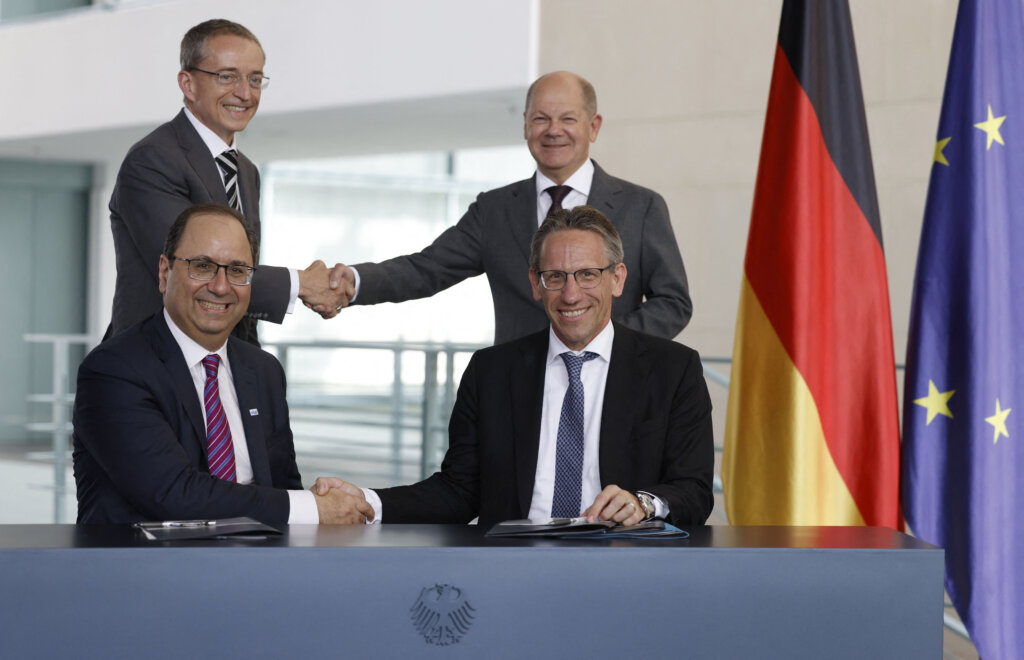
German Chancellor Olaf Scholz (background R) shakes hands with Pat Gelsinger (background L), CEO of US multinational corporation and technology company Intel, as State Secretary at the Chancellery Joerg Kukies (foreground R) and Intel Executive Vice President Keyvan Esfarjani (foreground L) also shake hands after signing an agreement between the German government and Intel on June 19, 2023 at the Chancellery in Berlin. (Photo by Odd ANDERSEN / AFP)
The most recent update is that Intel is in talks with Germany to increase the subsidies for a €20 billion plant in Magdeburg. The chip giant has also announced more than US$50 billion in investments to build new sites or expand existing manufacturing facilities in Ohio, Arizona, and Ireland.
In June, Intel said it would build a US$4.6bn semiconductor assembly and testing plant in Poland and is discussing building a similar plant in Italy. The wave of new facilities comes as Intel suffers a severe cyclical collapse in demand, putting a strain on its finances.
Experts are also questioning whether it can move fast enough with new manufacturing processes and chip designs to cash in on significant shifts in customer needs — such as the rise of artificial intelligence threatening to sideline Intel’s traditional PC and server chips market.
READ MORE
- Safer Automation: How Sophic and Firmus Succeeded in Malaysia with MDEC’s Support
- Privilege granted, not gained: Intelligent authorization for enhanced infrastructure productivity
- Low-Code produces the Proof-of-Possibilities
- New Wearables Enable Staff to Work Faster and Safer
- Experts weigh in on Oracle’s departure from adland

